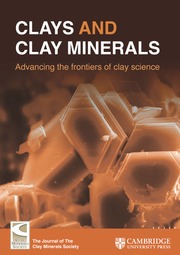Crossref Citations
This article has been cited by the following publications. This list is generated based on data provided by
Crossref.
Kwolek, Tomasz
Hodorowicz, Maciej
Stadnicka, Katarzyna
and
Czapkiewicz, Jan
2003.
Adsorption isotherms of homologous alkyldimethylbenzylammonium bromides on sodium montmorillonite.
Journal of Colloid and Interface Science,
Vol. 264,
Issue. 1,
p.
14.
Zhu, Lizhong
Chen, Baoliang
Tao, Shu
and
Chiou, Cary T.
2003.
Interactions of Organic Contaminants with Mineral-Adsorbed Surfactants.
Environmental Science & Technology,
Vol. 37,
Issue. 17,
p.
4001.
Xi, Yunfei
Ding, Zhe
He, Hongping
and
Frost, Ray L
2004.
Structure of organoclays—an X-ray diffraction and thermogravimetric analysis study.
Journal of Colloid and Interface Science,
Vol. 277,
Issue. 1,
p.
116.
Gates, Will P.
Nefiodovas, Andrew
and
Peter, Paul
2004.
Permeability of an Organo-Modified Bentonite to Ethanol-Water Solutions.
Clays and Clay Minerals,
Vol. 52,
Issue. 2,
p.
192.
Gates, Will P.
2004.
Crystalline swelling of organo-modified clays in ethanol–water solutions.
Applied Clay Science,
Vol. 27,
Issue. 1-2,
p.
1.
Slade, Phil G.
and
Gates, Will P.
2004.
The swelling of HDTMA smectites as influenced by their preparation and layer charges.
Applied Clay Science,
Vol. 25,
Issue. 1-2,
p.
93.
Lee, Seung Y.
Cho, Won J.
Hahn, Pil S.
Lee, Minhee
Lee, Young B.
and
Kim, Kang J.
2005.
Microstructural changes of reference montmorillonites by cationic surfactants.
Applied Clay Science,
Vol. 30,
Issue. 3-4,
p.
174.
Pérez-Santano, A.
Trujillano, R.
Belver, C.
Gil, A.
and
Vicente, M.A.
2005.
Effect of the intercalation conditions of a montmorillonite with octadecylamine.
Journal of Colloid and Interface Science,
Vol. 284,
Issue. 1,
p.
239.
Dultz, Stefan
Riebe, Beate
and
Bunnenberg, Claus
2005.
Temperature effects on iodine adsorption on organo-clay minerals.
Applied Clay Science,
Vol. 28,
Issue. 1-4,
p.
17.
Chen, Baoliang
Zhu, Lizhong
Zhu, Jiangxi
and
Xing, Baoshan
2005.
Configurations of the Bentonite-Sorbed Myristylpyridinium Cation and Their Influences on the Uptake of Organic Compounds.
Environmental Science & Technology,
Vol. 39,
Issue. 16,
p.
6093.
Meleshyn, Artur
and
Bunnenberg, Claus
2006.
Interlayer Expansion and Mechanisms of Anion Sorption of Na-montmorillonite Modified by Cetylpyridinium Chloride: A Monte Carlo Study.
The Journal of Physical Chemistry B,
Vol. 110,
Issue. 5,
p.
2271.
Volzone, C.
Rinaldi, J.O.
and
Ortiga, J.
2006.
Retention of gases by hexadecyltrimethylammonium–montmorillonite clays.
Journal of Environmental Management,
Vol. 79,
Issue. 3,
p.
247.
Maksimov, R. D.
Gaidukovs, S.
Kalnins, M.
Zicans, J.
and
Plume, E.
2006.
A nanocomposite based on a styrene-acrylate copolymer and native montmorillonite clay 1. Preparation, testing, and properties.
Mechanics of Composite Materials,
Vol. 42,
Issue. 1,
p.
45.
Panek, G.
Schleidt, S.
Mao, Q.
Wolkenhauer, M.
Spiess, H. W.
and
Jeschke, G.
2006.
Heterogeneity of the Surfactant Layer in Organically Modified Silicates and Polymer/Layered Silicate Composites.
Macromolecules,
Vol. 39,
Issue. 6,
p.
2191.
Ratinac, Kyle R.
Gilbert, Robert G.
Ye, Lin
Jones, Allan S.
and
Ringer, Simon P.
2006.
The effects of processing and organoclay properties on the structure of poly(methyl methacrylate)–clay nanocomposites.
Polymer,
Vol. 47,
Issue. 18,
p.
6337.
Önal, Müşerref
and
Sarıkaya, Yüksel
2007.
Some physicochemical properties of partition nanophase formed in sorptive organoclays.
Colloids and Surfaces A: Physicochemical and Engineering Aspects,
Vol. 296,
Issue. 1-3,
p.
216.
Marras, S.I.
Tsimpliaraki, A.
Zuburtikudis, I.
and
Panayiotou, C.
2007.
Thermal and colloidal behavior of amine-treated clays: The role of amphiphilic organic cation concentration.
Journal of Colloid and Interface Science,
Vol. 315,
Issue. 2,
p.
520.
Othmani-Assmann, H.
Benna-Zayani, M.
Geiger, S.
Fraisse, B.
Kbir-Ariguib, N.
Trabelsi-Ayadi, M.
Ghermani, N. E.
and
Grossiord, J. L.
2007.
Physico-Chemical Characterizations of Tunisian Organophilic Bentonites.
The Journal of Physical Chemistry C,
Vol. 111,
Issue. 29,
p.
10869.
Qi, Liyun
Liao, Wensheng
and
Bi, Zhichu
2007.
Adsorption of conventional and gemini cationic surfactants in nonswelling and swelling layer silicate.
Colloids and Surfaces A: Physicochemical and Engineering Aspects,
Vol. 302,
Issue. 1-3,
p.
568.
Ma, Jianfeng
and
Zhu, Lizhong
2007.
Removal of phenols from water accompanied with synthesis of organobentonite in one-step process.
Chemosphere,
Vol. 68,
Issue. 10,
p.
1883.

